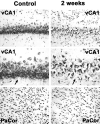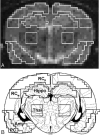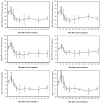Monitoring of acute generalized status epilepticus using multilocal diffusion MR imaging: early prediction of regional neuronal damage
- PMID: 17297006
- PMCID: PMC7977421
Monitoring of acute generalized status epilepticus using multilocal diffusion MR imaging: early prediction of regional neuronal damage
Abstract
Background and purpose: Diffusion-weighted MR imaging (DWI) has emerged as tool for noninvasive and early detection of neuronal alterations. The aim of this study was to investigate the evolution of acute phase changes in different brain regions during experimental status epilepticus (SE) using DWI correlated with SE-induced neuronal cell loss.
Methods: DWI was performed in 20 rats before (baseline) and 3, 5, 10, 15, 20, 30, 45, 60, 90, and 120 minutes after onset of pilocarpine-induced SE. Apparent diffusion coefficients (ADCs) were calculated for the parietal cortex, temporal cortex, pyriform cortex, hippocampus, amygdala, and thalamus and compared with baseline. Neuronal cell loss was quantified at different time points after SE using cresyl-violet-staining.
Results: ADC-mapping demonstrated a significant transient increase in ADC (to 116 +/- 4% of baseline) in the very acute phase, starting 3 minutes after SE onset, lasting for 10 minutes, followed by a significant gradual decline in ADC in all animals. Compared with surviving animals (76 +/- 7%), decline in ADC was significantly lower for the animals who died within 2 hours for all regions of interest (63 +/- 6.5%, 0.45 +/- 0.03 x 10(-3) mm(2)/s) except the thalamus (P < .01, analysis of variance). There was good correlation between neuronal cell loss in specific brain regions 2 weeks after SE and maximal decrease in ADC (r > 0.76).
Conclusion: Serial ultrafast DWI is a sensitive noninvasive technique for early detection and monitoring of seizure-induced neuronal alterations. Using ADC-mapping differentiation of regional severity of neuronal damage may be possible because there is good correlation between the maximal decrease in ADC in the acute phase of SE and late neuronal cell loss.
Figures



Similar articles
-
Early diffusion-weighted MRI predicts regional neuronal damage in generalized status epilepticus in rats treated with diazepam.Neurosci Lett. 2007 May 7;417(3):275-80. doi: 10.1016/j.neulet.2007.02.072. Epub 2007 Mar 2. Neurosci Lett. 2007. PMID: 17367928
-
Cerebral perfusion alterations during the acute phase of experimental generalized status epilepticus: prediction of survival by using perfusion-weighted MR imaging and histopathology.AJNR Am J Neuroradiol. 2005 Jun-Jul;26(6):1563-70. AJNR Am J Neuroradiol. 2005. PMID: 15956530 Free PMC article.
-
In vivo 1H magnetic resonance spectroscopy, T2-weighted and diffusion-weighted MRI during lithium-pilocarpine-induced status epilepticus in the rat.Brain Res. 2004 Dec 24;1030(1):11-8. doi: 10.1016/j.brainres.2004.09.025. Brain Res. 2004. PMID: 15567333
-
Rapid alterations in diffusion-weighted images with anatomic correlates in a rodent model of status epilepticus.AJNR Am J Neuroradiol. 2000 Nov-Dec;21(10):1841-52. AJNR Am J Neuroradiol. 2000. PMID: 11110536 Free PMC article.
-
Progression of brain damage after status epilepticus and its association with epileptogenesis: a quantitative MRI study in a rat model of temporal lobe epilepsy.Epilepsia. 2004 Sep;45(9):1024-34. doi: 10.1111/j.0013-9580.2004.08904.x. Epilepsia. 2004. PMID: 15329065
Cited by
-
Neuroimaging the epileptogenic process.Neurotherapeutics. 2014 Apr;11(2):347-57. doi: 10.1007/s13311-014-0258-1. Neurotherapeutics. 2014. PMID: 24488707 Free PMC article. Review.
-
Focal and Generalized Patterns of Cerebral Cortical Veins Due to Non-Convulsive Status Epilepticus or Prolonged Seizure Episode after Convulsive Status Epilepticus - A MRI Study Using Susceptibility Weighted Imaging.PLoS One. 2016 Aug 3;11(8):e0160495. doi: 10.1371/journal.pone.0160495. eCollection 2016. PLoS One. 2016. PMID: 27486662 Free PMC article.
-
Enhanced subcortical spreading depression in familial hemiplegic migraine type 1 mutant mice.J Neurosci. 2011 Apr 13;31(15):5755-63. doi: 10.1523/JNEUROSCI.5346-10.2011. J Neurosci. 2011. PMID: 21490217 Free PMC article.
-
Relationship between cortex and pulvinar abnormalities on diffusion-weighted imaging in status epilepticus.J Neurol. 2016 Jan;263(1):127-32. doi: 10.1007/s00415-015-7948-4. Epub 2015 Nov 3. J Neurol. 2016. PMID: 26530510
-
Diffusion-weighted magnetic resonance imaging as a cancer biomarker: consensus and recommendations.Neoplasia. 2009 Feb;11(2):102-25. doi: 10.1593/neo.81328. Neoplasia. 2009. PMID: 19186405 Free PMC article.
References
-
- Treimann DM, Meyers PD, Walton NY, et al. A comparison of four treatments for generalized convulsive status epilepticus. N Engl J Med 1998;339:792–98 - PubMed
-
- Lansberg MG, O’Brian MW, Norbash AM, et al. MRI abnormalities associated with partial status epilepticus. Neurology 1999;52:1021–27 - PubMed
-
- Jack CR, Sharbrough FW, Twomey CK. Temporal lobe seizures: lateralization with MR volume measurements of the hippocampal formation. Radiology 1990;175:423–29 - PubMed
MeSH terms
Substances
LinkOut - more resources
Full Text Sources
